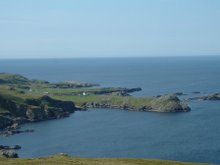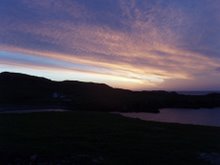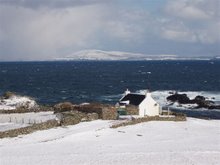I fulfilled an ambition this past week ... to get to the island of Havera. It's on the west side of Shetland, just north of Maywick (which is just north of Bigton). I went with Bobby Hunter (1/4 owner) from Burra (which is a couple of kilometres north of Havera ... all very confusing, you'll need a map!). It took 20-30 minutes on his boat. The island is almost cliff-bound and about a kilometre square and on the top is a windmill (unique in Shetland). There is no jetty.
From the top of the island there is a great view (telephoto above) south to the Holm - just west of St Ninian's Isle - and Fitful Head in the distance.
The island is of a hard limestone rock, the grass very green and the buildings neatly built. Fishing was very important to the community. There is a wee description of going off to the haaf (deep sea) in Andrew Jamieson's story ... page 74 of
A Kist of Emigrants.
There were 4-5 families living on the island up to about 1920. A schoolteacher recorded staying in the house above the cave and listening to, and feeling, the crash of the sea under the floor. There is still one lady (96) living (on Burra) who was born on the island.
The houses hug each other intimately between the steep banks of The Harbour and Hame Ham. Apparently, they were sheltered from the wind as it blew up the cliffs and over their heads. And, according to the schoolteacher, wee children were sometimes tethered like sheep so that they would not fall over the banks. That's Maywick in the background. The newly roofed house is used during the lambing when one or two people return for a couple of weeks in the spring.
On top of the island is the mill. There is very little water on the island ... no burns for a water mill and the people always brought water back if they went to Mainland. Somebody built the mill a long time ago. It was driven by the wind and the sails could be put out of which ever hole was the best for the wind direction. In the end it was not that successful.
There was also a tiny school in the centre of the island. No windows ... no distractions ... but probably a skylight on the thatched roof. There are lots of stories from the island of course ... one wee ten year old only attended school when the weather was not suitable for going off fishing. And of course there were wrecks and dramas.
There is no peat on the island which had to be cut across on Mainland at Deepdale (beyond the Holm of Maywick in the middle distance above) and brought back by boat. Not visible just south of the Holm is Bruce's Baa. Bruce was the laird whom the islanders drowned (or attempted to drown) by deliberately wrecking their old boat (with him in it) on the Baa (submerged rock). Pre-planned, they had with them another 'good' boat from Maywick which picked them up and left the laird behind!
I'm planning to do a book on the island and have the 'go-ahead' from two (so far) of the four part-owners (and descendants of the Havera folk). I would like it to be an attractive book with a broad appeal ... with poetry (not mine!) and art as well as a history of the island and its people.













